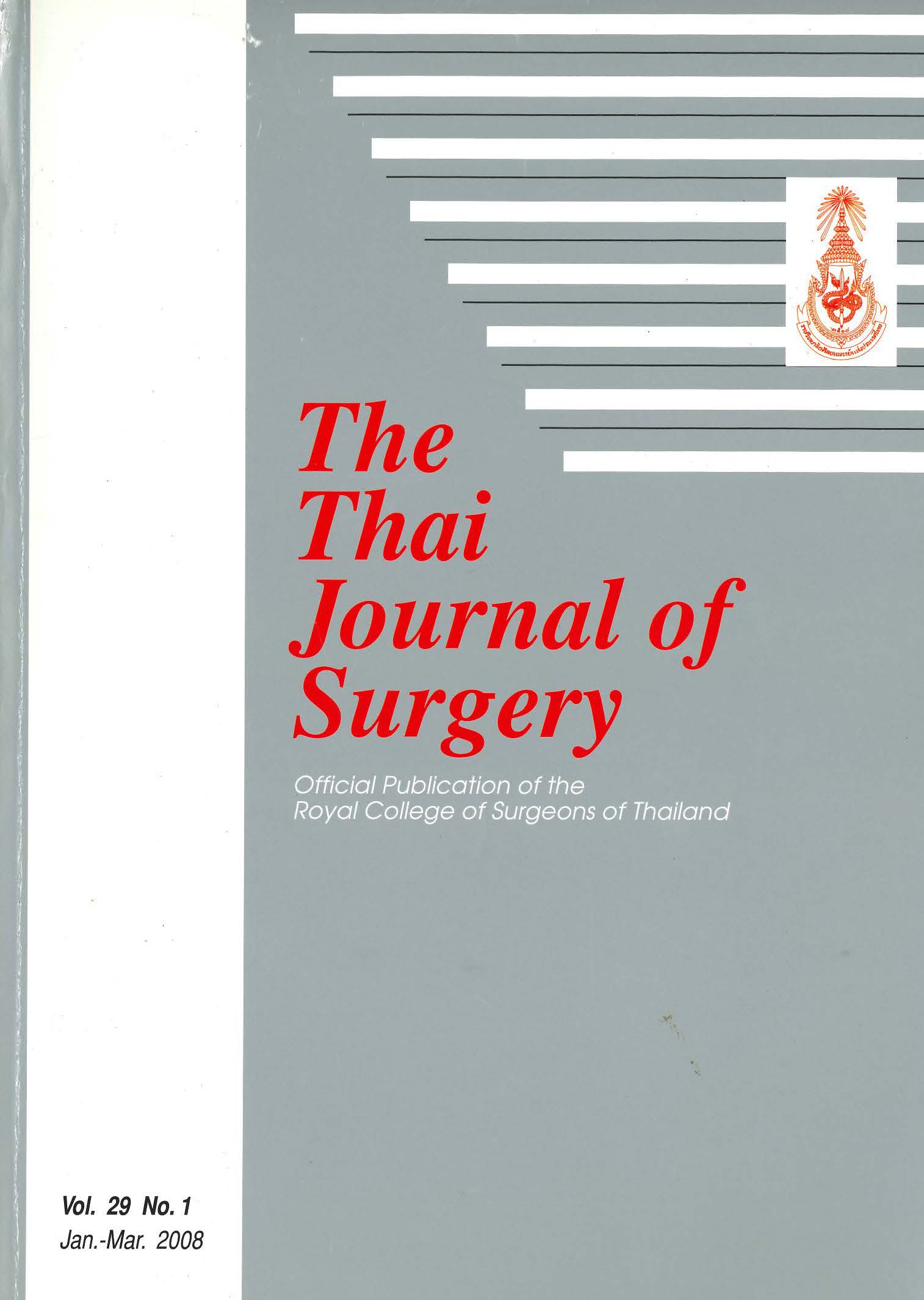Vascular Access Survival: A Comparison of Simple Autogenous Fistulas, Basilic Vein Transposition Fistulas and Prosthetic Grafts
Abstract
Objectives: Simple arteriovenous fistula (AVF), basilic vein transposition fistula (TAVF) and prosthetic bridge graft (AVG) provide good vascular access for hemodialysis. The 1- and 2-year results of such vascular access were assessed in this study.
Materials and Methods: From February 2006 to February 2008, 287 hemodialysis access procedures were performed in 274 consecutive patients at Maharat Nakhon Ratchasima Hospital, Bangkok Ratchasima Hospital and Saint Mary Hospital. Follow-up data of 204 procedures (149 AVF, 15 TAVF, and 40 AVG) in 191 patients were available for analysis. Functional patency rates were calculated with Kaplan-Meier method. Differences between patency rates of AVF, TAVF and AVG were determined with the Chi-square test.
Results: The cumulative functional patency rates at 1-year for TAVF, AVF, and AVG groups were 92.86%,89.34% and 83.47% respectively and at 2-year were 92.86%, 89.34% and 74.19% respectively. The cumulative functional patency of the TAVF group was superior to those of the AVF and AVG groups and the patency of the AVF group was superior to the AVG group.
Conclusions: Autogenous AV fistulas (AVF, TAVF) should be the initial access of choice because of their better patency.
References
2. Shemesh D, Zigelman C, Olsha O. Primary forearm arteriovenous fistula for hemodialysis access-an integrated approach to improve outcomes. Cardiovasc Surg 2003; 11:35-41.
3. Gibson KD, Gillen DL. Vascular access survival and incidence of revisions: a comparison of prosthetic grafts, simple autogenous fistulas, and venous transposition fistulas from the United States Renal Data System Dialysis Morbidity and Mortality Study. J Vasc Surg 2001;34:697-700.
4. Woo K, Farber A, Doros G. Evaluation of the efficacy of the transposed upper arm arteriovenous fistula: A single institutional review of 190 basilic and cephalic vein transposition procedures. J Vasc Surg 2007; 46:94-9.
5. Huber TS, Carter JW, Patency of autogenous and polytetrafluoroethylene upper extremity ateriovenous hemodialysis accesses: a systemic review. J Vasc Surg 2003; 38:1005-11,
6. Matsuura JH, Rosenthal D, Clark M. Transposed basilic vein versus polytetrafluorethylene for brachial-axillary arteriovenous fistulas. Am J Surg 1998;176:219-21.
7. Feldman HI, Kobrin S, Wasserstein A. Hemodialysis vascular access morbidity. J Am Soc Nephrol 1996;7:523-35.
8. Vassalotti JA, Falk A, Teodorescu V. The multidisciplinary approach to hemodialysis vascular access at the Mount Sinai Hospital. Mt Sinai J Med 2004;71:94-101.
9. Miller PE, Tolwani A, Luscy CP. Predictors of adequacy of arteriovenous fistulas in hemodialysis patients. Kidney Int 1999:56:275-80.
10. Huijbregts HJ, Bots ML, Moll FL. Hospital specific aspects predominantly determine primary failure of hemodialysis arteriovenous fistulas. J Vasc Surg 2007;45:962-7.
11. Lynn KL, Buttimore AL, Wells JE. Long-term survival of arteriovenous fistulas in home hemodialysis patients. Kidney Int 2004;65:1890-6.
12. Fan PY, Schwab SJ. Vascular access: concepts for the 1990s. J Am Soc Nephrol 1992;3:1-11.
13. Berman Ss, Gentile AT, Impact of secondary procedures in autogenous arteriovenous fistula maturation and maintenance. J Vasc Surg 2001:34:866-71.
14. Rao RK, Azin GD, Hood DB. Basilic vein transposition fistula: A good option for maintaining hemodialysis access site option. J Vasc Surg 2004;39:1043-7.
15. Choi HM, Lal BK, Cerveira JJ. Durability and cumulative functional patency of transposed and nontransposed arteriovenous fistulas. J Vasc Surg 2003;38:1206-11.
16. Taghizadeh A, Dasgupta P, Khan S. Long-term outcomes of brachiobasilic transposition fistula for hemodialysis. Eur J Endovasc Surg 2003;26:670-2.
Downloads
Published
How to Cite
Issue
Section
License
Articles must be contributed solely to The Thai Journal of Surgery and when published become the property of the Royal College of Surgeons of Thailand. The Royal College of Surgeons of Thailand reserves copyright on all published materials and such materials may not be reproduced in any form without the written permission.



